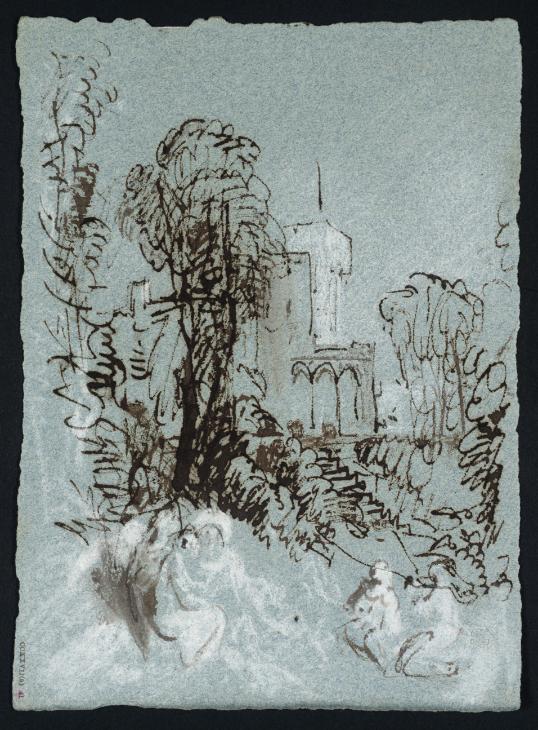Joseph Mallord William Turner East Cowes Castle from the West, with Figures among Trees near the Steps below the Conservatory 1827
Joseph Mallord William Turner,
East Cowes Castle from the West, with Figures among Trees near the Steps below the Conservatory
1827
Joseph Mallord William Turner 1775–1851
East Cowes Castle from the West, with Figures among Trees near the Steps below the Conservatory 1827
D20844
Turner Bequest CCXXVII a 41
Turner Bequest CCXXVII a 41
Chalk and ink on blue wove paper, 190 x 140 mm
Blind-stamped with Turner Bequest monogram bottom right
Inscribed in red ink ‘41’ bottom left, descending vertically
Stamped in black ‘CCXXVII(a) 41’ bottom left, descending vertically
Blind-stamped with Turner Bequest monogram bottom right
Inscribed in red ink ‘41’ bottom left, descending vertically
Stamped in black ‘CCXXVII(a) 41’ bottom left, descending vertically
Accepted by the nation as part of the Turner Bequest 1856
Exhibition history
2002
Turner Watercolours, Tate Britain, August 2002–May 2003 (no catalogue, as ‘The Grounds of East Cowes Castle, with Figures among the Trees; a study for “Boccaccio Relating the Tale of the Birdcage”’).
2007
Colour and Line: Turner’s Experiments, Tate Britain, London, April–November 2007 (no catalogue).
2013
Turner from the Tate: The Making of a Master, Art Gallery of South Australia, Adelaide, February–May 2013, National Gallery of Australia, Canberra, June–September 2013 (49, reproduced in colour, as ‘The Ground of East Cowes Castle, with Figures among the Trees; a Study for “Boccaccio relating the Tale of the Birdcage”’)
Turner from the Tate: The Making of a Master, Tokyo Metropolitan Art Museum, October–December 2013, Kobe City Museum, January–April 2014 (56, reproduced in colour, as ‘The Ground of East Cowes Castle, with Figures among the Trees; a Study for “Boccaccio relating the Tale of the Birdcage”’)
.
Turner from the Tate: The Making of a Master, Tokyo Metropolitan Art Museum, October–December 2013, Kobe City Museum, January–April 2014 (56, reproduced in colour, as ‘The Ground of East Cowes Castle, with Figures among the Trees; a Study for “Boccaccio relating the Tale of the Birdcage”’)
.
References
1827
A.J. Finberg, A Complete Inventory of the Drawings of the Turner Bequest, London 1909, vol.II, p.701, CCXXVII a 41, as ‘Fête galante’, c.1827.
Selby Whittingham, ‘What You Will; or Some Notes Regarding the Influence of Watteau on Turner and Other British Artists (1)’ Turner Studies, vol.5, no.1, p.18 ill.19, as ‘Fête galante’.
1987
Andrew Wilton, Turner in his Time, London 1987, reproduced p.151.
2006
Andrew Wilton, Turner in his Time, revised ed., London 2006, reproduced in colour, p.136.
The scene is near the foot of the steps below the smaller of East Cowes Castle’s two conservatories, with its arcaded south-western façade near the centre. The octagonal white tower to its right was actually some way beyond across a lawn level with the top of the steps. This drawing can be related to the painting Boccaccio Relating the Tale of the Birdcage, exhibited at the Royal Academy in 1828 (Tate N00507);1 see also Tate D20826 and D20832 (Turner Bequest CCXXVII a 23, 29). While differing in its specifics, the present sketch is the most directly comparable in its composition and spirit with the upright painting, presenting an elegant gathering in a glade below white towers.
The nebulous associations which may have caused Turner to link the modern, albeit medieval-style East Cowes with the Italian early Renaissance poet Boccaccio (1313–1357) and his Decameron story cycle of about 1351 (which does not feature a birdcage) are discussed by Martin Butlin and Evelyn Joll in their entry for the painting.2 The artist was probably also thinking of the work of his contemporary Thomas Stothard (1755–1834) in such paintings as Sans Souci, exhibited in 1817 (Tate N01829), and through him of Antoine Watteau (1684–1721) the originator of the Rococo ‘fête galante’ genre (a development of the rustic ‘fête champêtre’ mode). Watteau was referenced directly in the 1831 oil Watteau Painting by Fresnoy’s Rules (Tate N00514),3 which specifically addressed the issue of the spatial effect of areas of white in a painting, whether advancing or receding in relation to adjacent colours, an effect Turner may have had in mind while introducing strong white highlights into his blue paper East Cowes subjects. The distant white castle tower certainly makes its presence felt in the subsequent painting, and an elemental ‘colour beginning’ of a white tower against a blue sky of about that time (D25134; CCLXIII 12) may be related.
This is among dozens of blue paper studies made in and around the house, presumably during the same visit. For more on the various aspects of the building (demolished in about 1950), and its lost grounds as depicted by Turner, see the Introduction to this subsection, which touches on Turner’s possible introduction of imaginary elements to his topographical survey.
Martin Butlin and Evelyn Joll, The Paintings of J.M.W. Turner, revised ed., New Haven and London 1984, pp.151–2 no.244, pl.245 (colour).
Ibid., p.192 no.340, pl.341; for Watteau and Turner see Whittingham 1985, pp.2–24, and the second part of that article, Turner Studies, vol.5, no.2, Winter 1985, pp.28–48; see also Graham Reynolds, ‘Turner at East Cowes Castle’ in Victoria and Albert Museum Yearbook, vol.I, London 1969, p.74, Gerald Finley, Angel in the Sun: Turner’s Vision of History, Montreal and Kingston [Canada] 1999, p.121, and David Solkin, ‘Competing with Contemporaries’ in Solkin (ed.), Turner and the Masters, exhibition catalogue, Tate Britain, London 2009, pp.192–3.
Verso:
Blank; inscribed in pencil ‘Box 93’ bottom left, and ‘D20844’ bottom right.
Matthew Imms
November 2015
How to cite
Matthew Imms, ‘East Cowes Castle from the West, with Figures among Trees near the Steps below the Conservatory 1827 by Joseph Mallord William Turner’, catalogue entry, November 2015, in David Blayney Brown (ed.), J.M.W. Turner: Sketchbooks, Drawings and Watercolours, Tate Research Publication, November 2016, https://www

